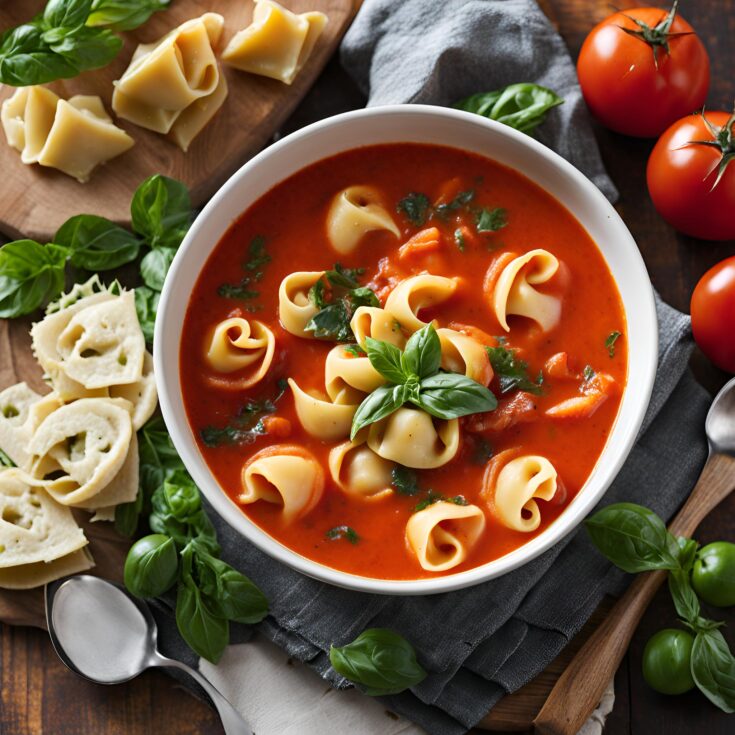Tomato Tortellini Soup Recipe
Introduction
Tomato tortellini soup is the perfect comfort food, blending the rich, tangy flavors of tomatoes with the satisfying bite of cheese-filled tortellini. This hearty, Italian-inspired soup is ideal for chilly days when you crave something warm and comforting. The soup’s simplicity and versatility make it a staple for both busy weeknights and leisurely weekend cooking. In this article, we’ll explore the ingredients, step-by-step preparation, tips for customization, and more, all to help you create the best tomato tortellini soup in your own kitchen.
Ingredients
To make tomato tortellini soup, you’ll need the following ingredients:
- 2 tablespoons olive oil: Adds depth of flavor and helps sauté the vegetables.
- 1 medium onion, finely chopped: Provides a sweet, aromatic base for the soup.
- 3 cloves garlic, minced: Enhances the soup with a savory, pungent flavor.
- 1 carrot, finely diced: Adds a slight sweetness and texture to the soup.
- 1 celery stalk, finely diced: Adds a subtle crunch and balances the flavor of the soup.
- 1 teaspoon dried basil: Infuses the soup with a classic Italian herb flavor.
- 1 teaspoon dried oregano: Adds a slightly bitter, earthy flavor.
- 1/4 teaspoon crushed red pepper flakes: Gives the soup a mild heat, which can be adjusted to taste.
- 2 tablespoons tomato paste: Concentrates the tomato flavor, giving the soup a richer taste.
- 4 cups vegetable broth: Forms the base of the soup, adding depth and richness.
- 2 cans (14.5 ounces each) diced tomatoes: Provides the primary tomato flavor and texture.
- 1 bay leaf: Adds a subtle, earthy note to the soup.
- Salt and pepper to taste: Season the soup to your preference.
- 1 package (9 ounces) refrigerated cheese tortellini: The star of the soup, bringing a soft, cheesy bite to every spoonful.
- 1/2 cup heavy cream: Adds richness and creaminess to the soup.
- 1/4 cup grated Parmesan cheese: For garnishing and adding a savory finish.
- Fresh basil leaves, chopped: Optional garnish for a fresh, herbal note.
Preparation
Step 1: Sautéing the Vegetables
Start by heating the olive oil in a large pot over medium heat. Once the oil is hot, add the chopped onion, carrot, and celery. Sauté these vegetables for about 5-7 minutes, or until they are softened and the onions are translucent. These vegetables form the flavorful base of the soup, known as a mirepoix, which provides a depth of flavor that complements the tomatoes.
Step 2: Adding Garlic and Herbs
Next, add the minced garlic, dried basil, dried oregano, and crushed red pepper flakes to the pot. Sauté for another minute, stirring constantly to prevent the garlic from burning. This step is crucial because it allows the garlic and herbs to release their flavors, creating a fragrant, aromatic base for the soup.
Step 3: Incorporating the Tomato Paste
Add the tomato paste to the pot, stirring it into the vegetables and herbs. Cook for 2-3 minutes, allowing the tomato paste to caramelize slightly. This step intensifies the tomato flavor and helps to thicken the soup.
Step 4: Adding the Broth and Tomatoes
Pour in the vegetable broth, and then add the diced tomatoes along with their juices. Stir well to combine all the ingredients. Add the bay leaf to the pot, and bring the mixture to a simmer. Reduce the heat to low, cover the pot, and let the soup simmer for 20-30 minutes. This simmering time allows the flavors to meld together and develop.
Step 5: Blending the Soup
After the soup has simmered, remove the bay leaf and use an immersion blender to puree the soup until smooth. If you don’t have an immersion blender, you can carefully transfer the soup in batches to a regular blender, then return it to the pot. Blending the soup creates a velvety texture that contrasts beautifully with the tortellini.
Step 6: Cooking the Tortellini
Once the soup is smooth, bring it back to a simmer and add the cheese tortellini. Cook the tortellini according to the package instructions, typically 5-7 minutes, or until they are tender. Be careful not to overcook the tortellini, as they can become mushy.
Step 7: Adding the Cream and Finishing Touches
After the tortellini are cooked, stir in the heavy cream. The cream adds richness and a silky texture to the soup, balancing the acidity of the tomatoes. Taste the soup and adjust the seasoning with salt and pepper as needed.
Customization and Variations
One of the best aspects of tomato tortellini soup is its versatility. Here are some ideas for customizing the recipe to suit your tastes and dietary preferences:
Protein Additions
- Chicken: Add cooked, shredded chicken to the soup for extra protein. This is a great way to use leftover rotisserie chicken.
- Italian Sausage: Browned Italian sausage adds a savory, spicy element to the soup.
- Beans: For a vegetarian protein option, consider adding a can of drained and rinsed white beans, such as cannellini or navy beans.
Vegetable Enhancements
- Spinach: Stir in a few handfuls of fresh spinach leaves during the last few minutes of cooking. The spinach wilts quickly and adds a vibrant color and additional nutrients to the soup.
- Zucchini: Add diced zucchini along with the other vegetables for a slightly different texture and taste.
- Mushrooms: Sautéed mushrooms can add a meaty texture and umami flavor to the soup.
Dairy-Free and Vegan Options
- Coconut Milk: Replace the heavy cream with coconut milk for a dairy-free version. The coconut milk adds a subtle sweetness that pairs well with the tomatoes.
- Vegan Tortellini: Use vegan cheese tortellini to make the soup entirely plant-based. These can be found in specialty stores or made at home.
Flavor Boosters
- Balsamic Vinegar: A splash of balsamic vinegar added at the end of cooking can enhance the tomato flavor and add a slight tanginess.
- Fresh Herbs: In addition to basil, try adding fresh oregano or parsley as a garnish for an extra burst of flavor.
- Parmesan Rind: If you have a Parmesan rind on hand, add it to the soup during simmering to infuse the broth with a deep, savory flavor. Remember to remove it before blending the soup.
Serving Suggestions
Tomato tortellini soup is a hearty meal on its own, but it can be paired with a variety of side dishes to create a complete meal:
- Garlic Bread: Serve with a side of warm, crusty garlic bread to soak up the flavorful broth.
- Salad: A simple green salad with a light vinaigrette complements the richness of the soup.
- Grilled Cheese: A classic pairing, grilled cheese sandwiches make a comforting and filling accompaniment.
- Bruschetta: Top slices of toasted baguette with fresh tomatoes, basil, and mozzarella for a light, refreshing side dish.
Storing and Reheating
Storage Tips
Tomato tortellini soup can be stored in an airtight container in the refrigerator for up to 3 days. If you plan to make the soup ahead of time, consider cooking the tortellini separately and adding it to the soup when reheating to prevent it from becoming too soft.
Freezing Instructions
This soup freezes well, but it’s best to freeze it without the tortellini, as the pasta can become mushy when thawed. Simply prepare the soup up to the point of adding the tortellini, then let it cool completely before transferring it to freezer-safe containers. The soup can be frozen for up to 3 months. When you’re ready to serve, thaw the soup in the refrigerator overnight, reheat it on the stove, and add freshly cooked tortellini.
Reheating Tips
To reheat the soup, warm it gently on the stove over medium heat, stirring occasionally. If the soup has thickened during storage, add a splash of broth or water to thin it to your desired consistency. If reheating in the microwave, heat in 1-minute intervals, stirring between each interval until the soup is heated through.
Nutritional Information
Tomato tortellini soup is a balanced meal that provides a good mix of carbohydrates, protein, and fat. Here’s a general nutritional breakdown for a typical serving of this soup:
- Calories: Approximately 350-400 calories per serving.
- Carbohydrates: Around 30-35 grams, primarily from the tortellini and vegetables.
- Protein: About 10-15 grams, depending on the type of tortellini used.
- Fat: Roughly 20 grams, mostly from the olive oil, cream, and cheese.
For those watching their intake, consider using whole wheat tortellini, reducing the amount of cream, or using a dairy-free alternative to lower the fat content.
Frequently Asked Questions (FAQs)
1. Can I use canned tomato soup instead of diced tomatoes?
Yes, you can substitute canned tomato soup for diced tomatoes, but it will change the flavor and texture of the soup. Canned tomato soup is typically sweeter and less chunky than diced tomatoes. If using tomato soup, reduce or eliminate the added salt, as tomato soup often contains sodium.
2. What can I substitute for tortellini if I don’t have any?
If you don’t have tortellini, you can use other types of filled pasta, such as ravioli. Alternatively, plain pasta shapes like penne or farfalle can be used, though the soup will lose some of its creamy, cheesy richness.
3. How can I make this soup gluten-free?
To make the soup gluten-free, simply use gluten-free tortellini or another gluten-free pasta. Ensure that your vegetable broth and any other processed ingredients are also gluten-free.
4. Can I add meat to this soup?
Absolutely! Cooked sausage, ground beef, or shredded chicken can be added to the soup for a heartier, meatier version. Simply brown the meat before adding it to the soup or stir in cooked meat at the end.
5. What type of broth should I use?
Vegetable broth is used in the recipe to keep it vegetarian, but chicken broth can also be used for a richer flavor. If using chicken broth, you might need to adjust the seasoning, as it can be saltier than vegetable broth.
Conclusion
Tomato tortellini soup is a delightful blend of flavors and textures, offering comfort in every bowl. Whether you’re enjoying it on a cold winter day or serving it as part of a larger meal, this soup is sure to satisfy. Its versatility makes it easy to adapt to your personal preferences, and with the right side dishes, it can become a star in your dinner rotation. Follow the steps and tips outlined in this guide, and you’ll be able to create a tomato tortellini soup that’s rich, creamy, and utterly delicious. Enjoy!
Tomato Tortellini Soup Recipe

Tomato tortellini soup is the perfect comfort food, blending the rich, tangy flavors of tomatoes with the satisfying bite of cheese-filled tortellini. This hearty, Italian-inspired soup is ideal for chilly days when you crave something warm and comforting. The soup’s simplicity and versatility make it a staple for both busy weeknights and leisurely weekend cooking. In this article, we’ll explore the ingredients, step-by-step preparation, tips for customization, and more, all to help you create the best tomato tortellini soup in your own kitchen.
Ingredients
- 9 ounces frozen cheese tortellini
- 2 (10.75 ounces) tomato soup
- 2 cups chicken broth
- 2 cups milk we used skim
- 2 cups half and half
- ½ cup sun dried tomatoes
- 1 teaspoon onion powder
- 1 teaspoon garlic powder
- 1 teaspoon dried basil
- ½ teaspoon salt
- ½ cup shredded Parmesan cheese
Instructions
- Cook tortellini according to package directions.
- Meanwhile, in a large stock pot, combine the soup, broth, milk, cream, tomatoes and seasonings. Heat through, stirring frequently. Drain tortellini and carefully add to soup. Stir in cheese. Sprinkle each serving with additional cheese if desired.
Notes
One of my favorite things to do for chicken noodle soup and a lot of our other soup recipes is to make homemade chicken broth from scratch and use the chicken broth in later recipes.
Nutrition Information:
Amount Per Serving: Calories: 260


